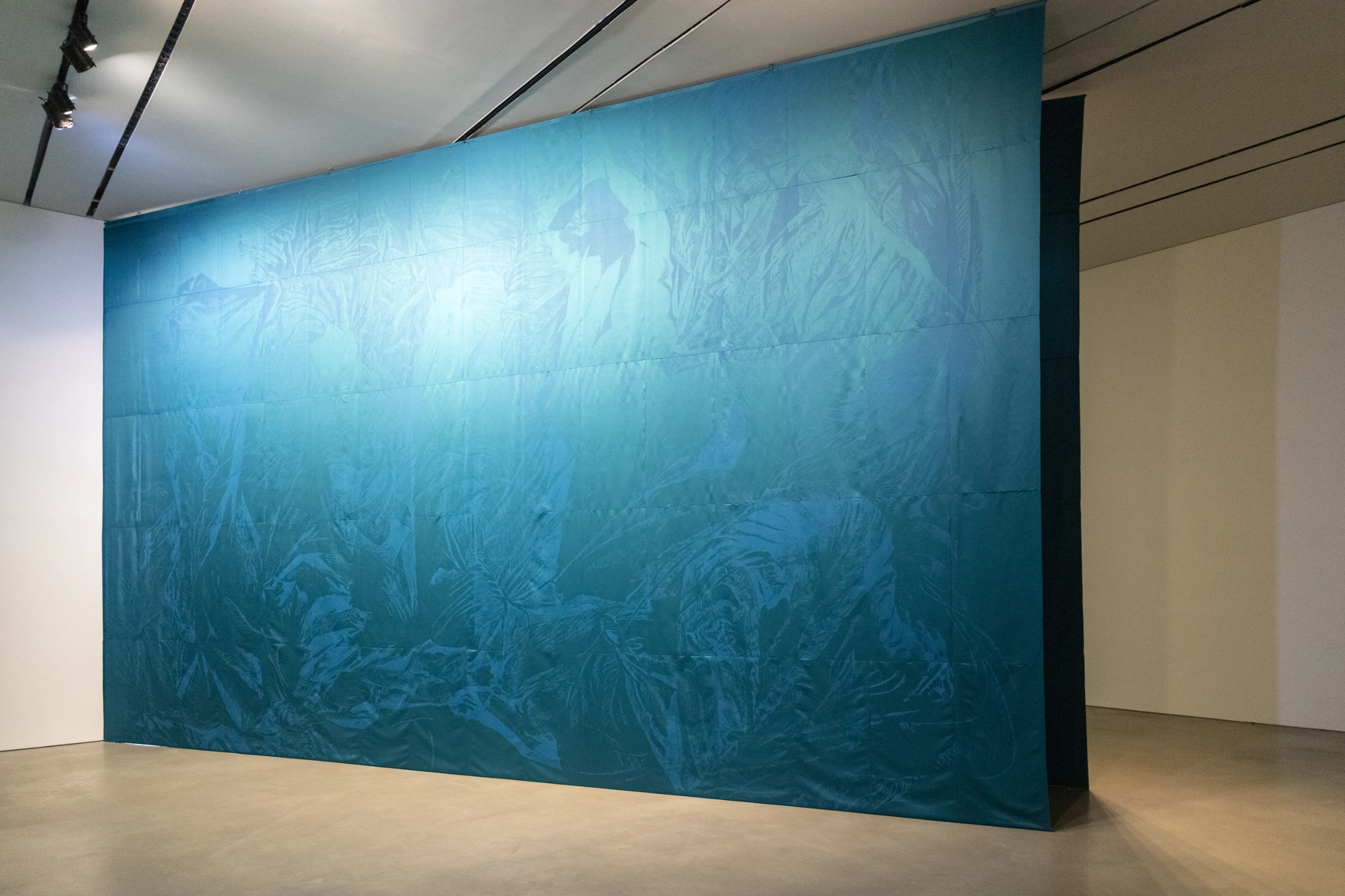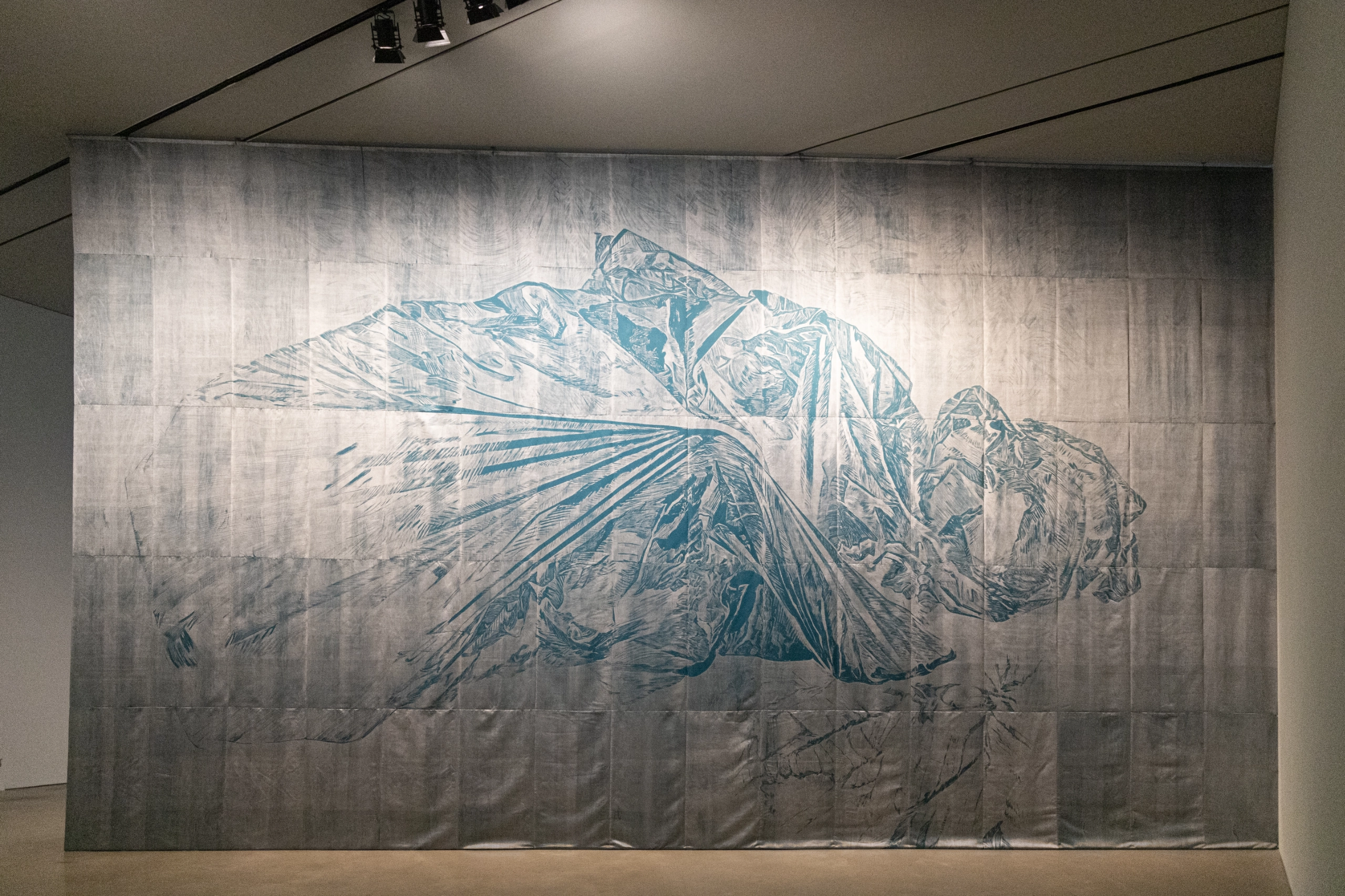
Works Audio description
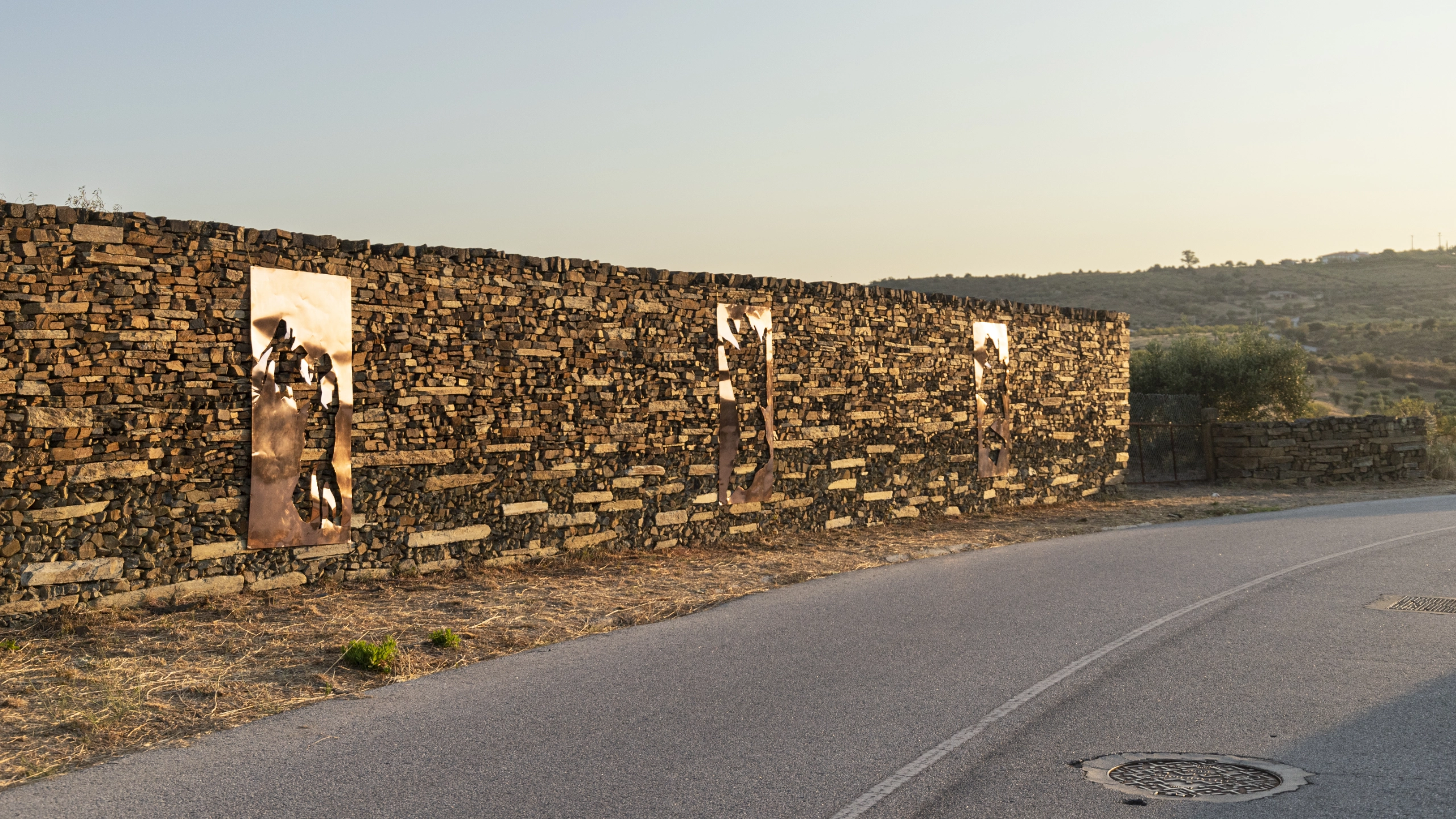
Outside the Côa Museum complex, in the open air, a long stone wall, located on the grassy banks of a paved and slightly curvilinear road on ‘Rua do Museu‘, receives the intervention of the artist Ana Torrie.
Three 0.3 millimeter thick copper plates, each measuring 1 meter wide by 2 meters high, are affixed to this small wall at regular intervals between each other and the boundaries of this building.
The thin rectangular sheets are oriented vertically and appear as posters of unique images on the reddish-brown metal surface. The freely cut shapes inside each piece (sometimes with curved lines, sometimes straight, with sinuous and pointed endings) portray silhouettes of abstract figures, emerging from the spontaneous contours promoted by butchers with varying rhythms.
The wall that serves as support for the artistic installation is built with shale stones of different sizes, shapes, colors and textures. They are predominantly brown and gray elongated cobblestones, with smooth and rough faces, stacked using the dry stone construction technique (without visible mortar). Despite the irregular finish at its top, the shales form a wide monolith (but not very tall), which stands out from the background: an open field with hills and sparse vegetation. Above the highest part of the structure, it is possible to see some foliage, as well as a low metal gate at one of its ends.
Due to the cutouts made in the metal sheet, the work adds a distinct visual element to the surroundings, which in contrast to the natural stone pattern revealed inside – and also beyond its edges – creates unexpected lively elements. And, due to the reflective nature of the material, it dynamically mirrors and deforms the surrounding landscape, depending on the brightness of the day and the movement of the observer.

Outside the Côa Museum, in front of the parking lot, artist Ana Torrie presents a large abstract sculpture (approximately 3.5 meters long, 1.3 meters wide, and 1.7 meters high). The piece is placed on top of the rocky walls that support the establishment’s viewpoint, which offers a panoramic view of the mountainous landscape with distant hills and terraced slopes with primarily shrubby vegetation.
The sculptural object, which resembles an invented wild animal, is constructed from a combination of wooden beams and numerous metal plates. It was based on the graphic representation of a fantastic creature depicted in the artwork “Shape 3” – by artist Samuel Ornelas – (available for viewing in the temporary exhibition room 2 of the museum).
The main structure of the sculpture consists of rectangular wooden bars (joined by screws, nuts, and washers), forming a skeletal structure with sharp triangular designs and simple straight-line appendages (sometimes also angled), providing a basal structure with four supports on the stone ground.
These struts, which resemble long arms and legs, are placed in an imposing posture and extend outward, like a frame that keeps a central mass of entangled metal pieces floating inside, which make up the creature’s skull, body, tail, and claws.
This body of twisted blades resembles an armour made of metal scales, with voluminous heads and backs and long, slender extremities. The tail tapers off, using progressively smaller plates until its end. The fingers have cylindrical phalanges with sharp tips.
The cylinders and curvilinear sheets are materials with a shiny surface, made of copper (with reddish-brown hue) and zinc (with a silver-gray colour), of minimal thickness and with different sizes and shapes, with irregular sharp and rounded edges.
Each metal plate is a chalcographic matrix, which contains old engravings by the artist produced using etching and aquatint techniques. On some it is possible to see plant leaves and anthropomorphic characters. The countless engraved pieces are connected to the wooden structure and to each other by metal wires, yet maintaining some slack, to the point that they react dynamically to the presence of the wind, hissing and tinkling as the air passes through.
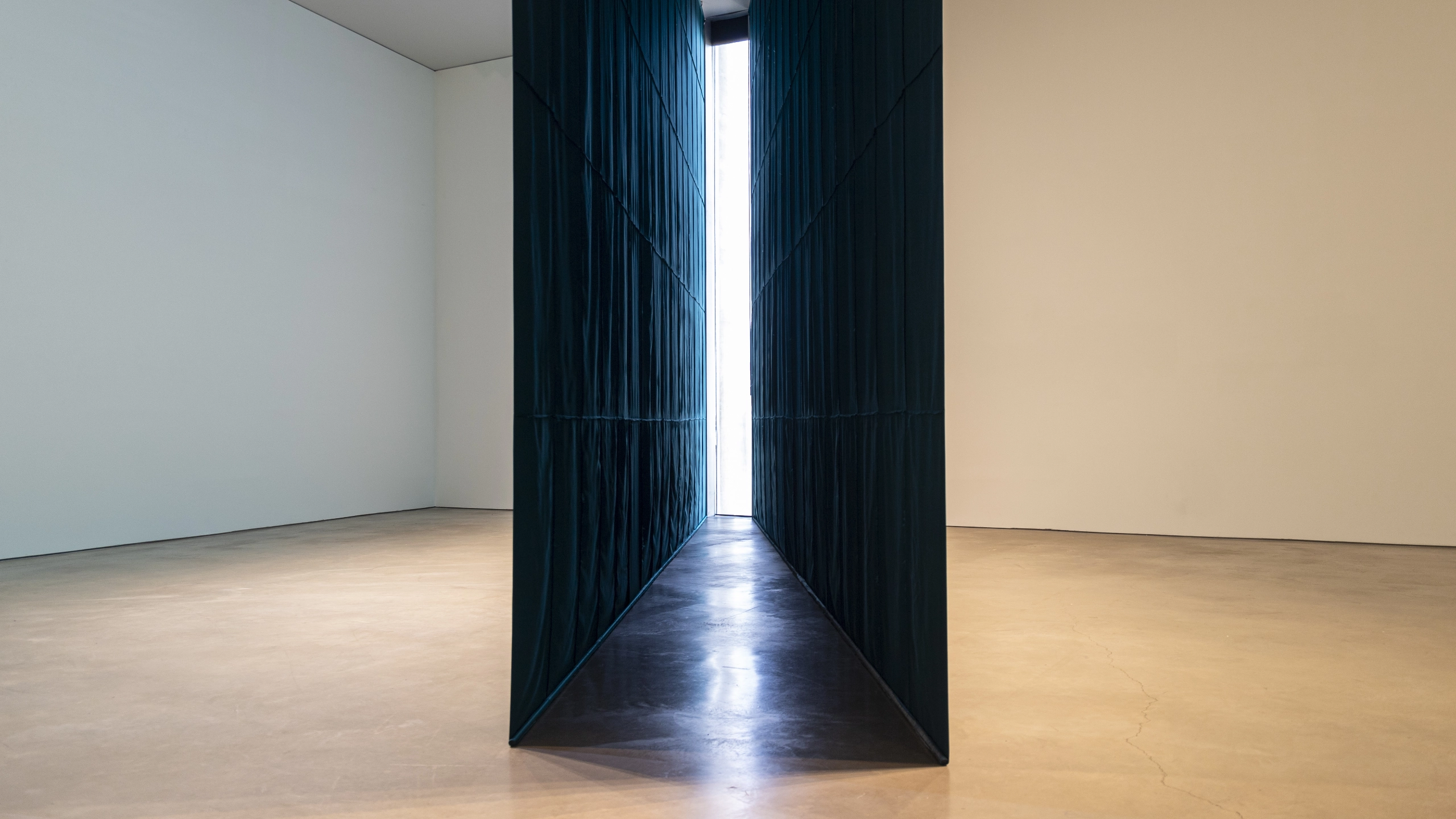
Facing the entrance to Room 2, along the diagonal line of the trapezoidal gallery – from its longest wall, cut by a narrow and tall window (60 cm wide and identical in height to the room’s ceiling) – the artist Samuel Ornelas displays his work composed of two large-scale fabrics, which exhibit (on opposite sides of each other) prints derived from hand-printed woodcut matrices.
The tall curtains are suspended vertically, almost parallel, like a dark interior corridor that narrows towards the natural light source at its end.
The installation shares three main perspectives. The first two: by observing the drawings engraved on both fabrics on the outer part of each mural. And the third: by appreciating and interacting with the tunnel-shaped passage with views of the external landscape.
Outside this designed path, the work is framed by the empty white walls and the light ceiling of the room; and is highlighted by lights directed at its printed side – which spread through the fabric and also reflect on the polished concrete floor.
Each panel is composed of 80 rectangular pieces of smooth, thin, synthetic fabric (100% polyester), in petroleum green color. These fragments are juxtaposed in a grid of 16 columns and 5 rows, totalling 10 meters wide by 6 meters high.
The first piece, to the left of the entrance door, is the mirrored reproduction of the woodcut matrix that is available for viewing in Room 3 of the museum.
The composition formed by unique images, printed only in metallic blue offset ink, is presented subtly, due to the low contrast with the background color.
Despite this, it is a patchwork of complex drawings that depict abstract forms similar to draped fabrics and other organic elements, such as foliage, shapes of wild animals, and human silhouettes in motion.
Traces of the figures in this tangle emerge as the observer moves through the gallery, physically changing their point of view. The variation in proximity to the work reveals new lines, previously hidden by the concentrated incidence of light, and hides graphics that were obvious on the surface.
The second textile element reproduces a new print with the same technique, but in a contrasting silver-gray tone, which dominates the edges in uniform color blocks (which still show the texture of the wood grain) and centralizes the primary subject of the depicted scene.
The fundamental object is a representation of a reclining human body covered by a long fabric with folds and creases, whose volumes can also be perceived as natural contours of mountainous and valley territories, as well as parts of anatomical structures inspired by wild animals.
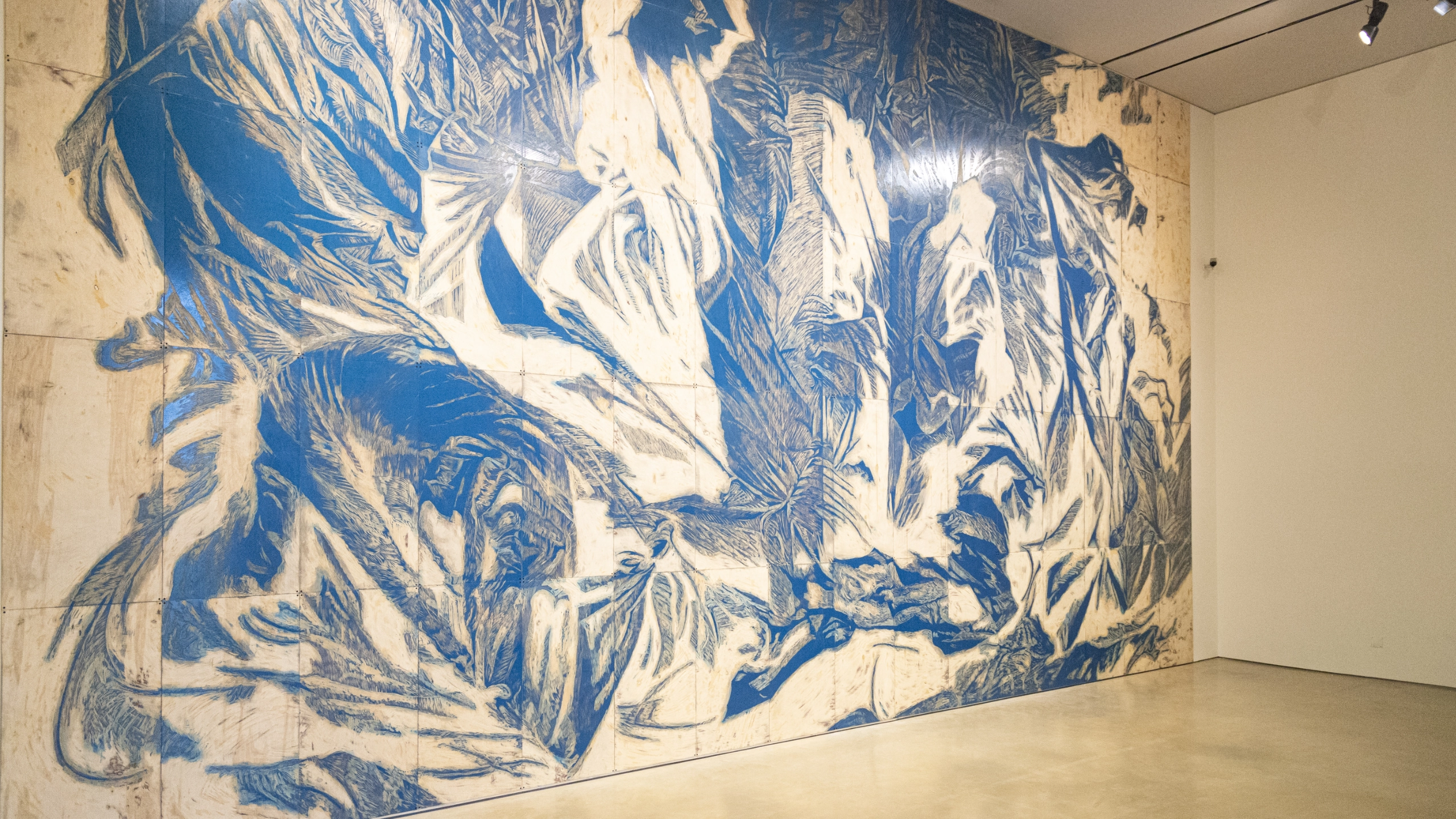
In the reserved rectangular space of room 3, the artist Samuel Ornelas displays a mural of large-scale woodcut matrices. Occupying almost the entirety of one wall of the small gallery, the work is made up of 80 vertical Birch plywood boards with Tola wood veneer, arranged in 16 columns and 5 rows, which extend from floor to ceiling (6 meters high), and from one end of the wall to the other (10 meters wide).
The direct lighting, projected by overhead sources and mixed color temperatures, highlights the metallic blue of the offset ink applied over the entire high relief image of the wooden panel, in contrast with the adjacent sides of the room (white and unadorned), with the gray polished burnt cement floor and the slightly yellowish tone of the carved plywood.
The mural features an intricate composition of drawings that depict abstract shapes resembling draped fabrics and other organic elements such as foliage, wild animal shapes, and moving human silhouettes.
The cuts made by the gouge and other cutting tools create contours, volumes, lights and shadows, through lines and patterns with varying thicknesses or by the total removal of the outermost layer, in order to cause a symbiotic amalgamation between these deconstructed figures that nonetheless preserve their essence.
The print resulting from this set of matrices can be seen in the work “Shape 3”, located in room 2 of the same exhibition complex.
